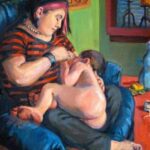When I delivered my first child by C-section, I was determined to breastfeed even though I had been told that it would be difficult. While I was still in recovery from the c-section, my daughter and I made our first foray into the painful world of breastfeeding. Unfortunately, I found it excruciatingly painful. And, because my milk had not yet come in, my daughter found it frustrating.
Nevertheless, we persisted in our joint venture. As the days wore on, I dutifully exposed my breast to every nurse and lactation consultant who came into my hospital room. My nipples soon became cracked and bloody, and I cried at the mere thought of attaching my little leach to my breast. I slathered Purelan and Lansinoh on my nipples at every opportunity, but to no avail.
Although my daughter gained weight, my breasts were engorged and painful to the slightest touch, and my nipples felt as though they were on fire. After just two and a half weeks of breastfeeding, I decided to move on to formula feeding. My daughter and I happily bonded over Enfamil and Similac and never looked back. For us, having a good bottle feeding experience was better than having a bad breastfeeding experience.
When my son was born by c-section, I decided to try breastfeeding again. After all, a different baby and a different pregnancy might mean that we could be successful. However, our first attempts at breastfeeding were likewise painful and frustrating. In addition, my son wanted nothing to do with feeding for the first 20 hours of his life after the c-section. I was afraid that I had failed once again.
On our last day in the hospital, a lactation consultant visited our room. I tearfully explained to her the problem and once again dutifully exposed my breast for her examination. She watched my son latch on and immediately saw the problem. My son’s lower jaw was just a bit receded, which prevented him from properly latching on. Even if I tilted his head back, we still had difficulty.
With this information in hand, the lactation consultant rushed off with a promise to return shortly with something that would help. When she returned, she carried with her a Medela nipple shield. The thin silicone device fitted over my nipple with a small cut out that left my son’s nose free. The nipple area itself had four tiny holes to permit breast milk to flow through freely.
Using the Medela nipple shield for the first time was a little awkward, but my son caught on even faster than I did. He did not hesitate to latch on, and happily fed himself into a breast milk coma.
From that point on, I used the Medela nipple shields. Although I tried another brand, Ameda, I found them too stiff and difficult to use. I threw out the Lansinoh because I had no trouble with cracked, bruised or bloody nipples. Using the Medela nipple shields kept me free from any kind of pain. Even when my milk came in, I was not engorged. My son was able to feed on his schedule and rapidly gained weight.
Breastfeeding is possible, even if you have had a bad experience in the past or gave birth by c-section. Breastfeeding does not have to be painful or frustrating, even if your newborn has a bad latch. Moreover, the nipple shields may provide you with enough relief to get past the difficult stages of breastfeeding that you can eventually do without them.
Despite the notion that breastfeeding is “natural,” it may not be easy for every woman, particularly after a c-section. If your dream is to breastfeed but you are encountering difficulty, try talking to an experienced lactation consultant or invest in a Medela nipple shield on your own.

